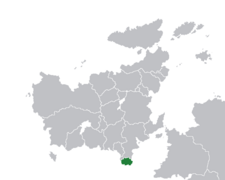Vitruvia: Difference between revisions
No edit summary |
No edit summary |
||
| Line 1: | Line 1: | ||
{{wip}} | |||
{{Infobox country | {{Infobox country | ||
|conventional_long_name = Confederacy of Vitruvia | |conventional_long_name = Confederacy of Vitruvia | ||
Revision as of 14:52, 12 March 2023
This article is incomplete because it is pending further input from participants, or it is a work-in-progress by one author. Please comment on this article's talk page to share your input, comments and questions. Note: To contribute to this article, you may need to seek help from the author(s) of this page. |
Confederacy of Vitruvia | |
|---|---|
| Motto: | |
| Anthem: Inno della Virtuviu "Hymn of Vitruvia" | |
Location of Vitruvia (in light green), within Euclea (light grey) |
Etymology
The name "Vitruvia" originates from the Solarian architect Vitruvius who was widely regarded as the founder of Solarian architecture. Vitruvius helped in originating the Solarian idea that all buildings should have firmitas, utilitas, and venustas ("strength", "utility", and "beauty") which was later taken up by general Solarian architecture. Many of the works attributed to Vitruvius ended up in modern day Vitruvia during a period of latinizaton, which lead to the Solarian name for the land "Vitruvio".
This name later replaced the native name for the land, roughly known as "Muntidimare", over the years which it was inhabited by the Solarian Empire. When the Solarian Empire collapsed, the Vitruvian Maritime Republic formed and kept the name pinned by the Solarians.
History
Prehistory
- -Vitruvia has been inhabited consistently for around 11,000 years.
- -Vitruvia was visited early by !Phoenicians who brought with them an early form of the !Semitic language
Early History
- -Vitruvia was entirely colonised by the Piraean Territories in 750BC that lasted until 200BC. Due to it’s proximity to the antipode, Vitruvia became subject to Piraeanisation (the process of Piraean architecture and cultural customs being introduced to Vitruvia) which can still be seen in modern day.
- -It was also during the Piraean Empire in which the Solarian Catholic Church was introduced to the land.
- -The land is invaded by Etruria however the culture and language splits due to influence from Rahelia. This gave way for the evolution of the Vitruvio language.
- -From AD 308-420 Vitruvia was governed under the Solarian Empire.
- -Apon the collapse of the Solarian Empire Vitruvia became a profitable united merchants republic.
Early Modern History
- -1553: Doge Yannick Ventura funds a voyage of Vitruvio’s heading to establish a small trade colony in Asterias Superior.
- -1677: War waged with Etruria over control of maritime passages in the Solarian Sea
- -1704: Vitruvia invaded and annexed by Etruria, incorporated as a constituent.
- -1755: Vitruvian Uprising brings about the Vitruvian War for Independence, which is won due to Etruria having greater issues to deal with and fearing Vitruvia would keep fighting for independence until the end.
Modern History
- -1854: Vitruvia converts from a Maritime Republic to a Parliamentary Republic
- -1913: Vitruvia is partially affected by the Great Collapse however less than most due to a lack of funds invested in the Weisstadt Stock Exchange.
- -1925: Vitruvia aligns itself with the Grand Alliance during the Great War, assisting by sending Vitruvian soldiers to various Euclean fronts.
- -1955: Vitruvian government has a complete reform, introducing the unicameral parliamentary republic
Politics and Government
Geography
Economy
Demographics
Culture
Architecture
Vitruvian architecture reflects it's culturally diverse history and influence from other Solarian cultures and architectural styles which have been brought to Vitruvia over the course of history. Some of Vitruvia's earliest inhabitants, prior to Piraean occupation, constructed the Giantess which stands as one of the oldest manmade freestanding structures in the world.



